Meet the Council: Willingness to Adapt is Key for Managing Canadian Beef Operations
The Beef Cattle Research Council (BCRC) is made up of producer members from across Canada, representing and appointed by each of the provincial beef organizations that allocate part of the Canadian Beef Cattle Check-Off to research. The number of members from each province is proportional to the amount of provincial allocation to research.
The following is part one in a series to introduce you to this group of innovative thinkers that set BCRC’s direction by sharing practices, strategies, or technologies that they have integrated into their own operations. Read part two of this series.
Although located in different regions across the country, the following three producers all agree that being able to change and adapt is key when implementing new practices on their operation.
Rotating Wintering Sites in Treed Landscapes

Dean Manning – Nova Scotia
Dean and his family have a mixed farm in the Annapolis Valley near Falmouth, Nova Scotia. There they raise vegetables to sell at farmers’ markets and have a herd of 80 Angus crossbred cattle. Farming in this unique area, alongside all forms of agriculture from greenhouses and wineries to dairy and hogs, has provided the Mannings with opportunities and challenges. With a limited land base that is surrounded primarily by housing developments, the Mannings realized that to produce more they had to become more efficient as expansion is not an option. The advantage is that land is very productive, and the moisture received makes for favourable growing conditions for forages and other crops.
Selling products directly to consumers as well as being located so near to the public has shaped the outlook Manning has on farming. “The customer is always right. If they are saying they want or don’t want something, then I have to do it,” Manning explains. “It’s not about what I believe, it’s about having a product they are willing to buy.”

Although they try to manage their cattle as extensively as possible, the wet climate means that they must house some classes of cattle in barns through the winter. They use concrete pads to stockpile manure over the winter and then spread in the spring when the fields are dry enough or in the fall before it freezes.While in university, Manning first started learning about extended grazing and once returning to the farm began to try different practices. Over the years they have continued to experiment with different grazing strategies and have learned that being flexible and changing plans based on the conditions and environment are key for any method of grazing to succeed.
In recent years they have started applying the concepts of rotational and adaptive grazing to their wintering sites as well. Wooded or treed areas are common on the Manning farm and are used for logging, to provide wildlife habitat, and to provide shelter to cattle that are wintered extensively.
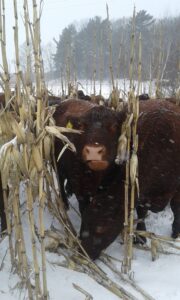
Manning fences off a portion of the trees and allows cattle access for all or part of the winter. Limiting access to the trees allows for manure to be spread out over the site, provides clean and fresh calving areas in the spring, avoids concentrating cattle on the tree roots over a long period of time which can cause trees to die off, and helps to provide habitat for wildlife species. Manning will sometimes fence off entire sections of trees, 10-15 feet out from the edge of the treeline. This allows the trees to still provide shelter but prevents cattle damaging the trees.
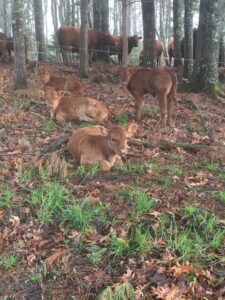
Manning is cautious and strategic about selecting wintering sites, but is flexible and says there is no set rotation. Wooded areas are evaluated for regrowth, how well they hold up in wet conditions, and what direction cattle will be able to shelter from the wind. Manning avoids wintering on the same site two years in a row and also tries to stay out of areas that have recently had trees cut or have a lot of sensitive regrowth. He also restricts cattle access to areas in early spring when trees are budding out. Management of these wintering sites is similar to the strategies employed for grazing paddocks. Even though relatively little grazing occurs in treed areas, Manning is aiming to match the wintering site to the cattle needs and vice versa.
The treed areas surround their winter-feeding paddocks where they use either bale grazing or strip grazing of corn, or kale in more recent years. Although they always have a set plan going into the winter, Manning notes that in his area having a backup plan is essential. Storms, wet conditions, ice, or mud often limit what they are capable of doing with extended grazing. For example, last year’s hurricane knocked down all of their corn at a 45-degree angle meaning they were forced to silage rather than graze it to prevent a total loss if it were buried in wet snow.
Grazing Silage
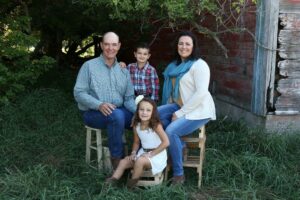
Melissa Atchison – Manitoba
Melissa, along with her family and husband’s parents, own and operate Poplarview Stock Farms, a cow-calf and backgrounding operation with 650 cows and small cash cropping operation near Pipestone, Manitoba. Atchison describes their location as “where sandhills meet sloughs” with the majority of the land being either marshy or sandy. Their land base comes with both opportunities and challenges. Finding grazing and land management techniques that ensure the fragile landscape stays intact is not easy, however they have adopted extended grazing practices as a low-cost way to maintain their herd as well as promote healthy soils.

Atchison has always liked the idea of feeding silage as a way to put up a large volume of high quality feed in a relatively short amount of time, but found the cost and logistics of delivering it to the cows was prohibitive. The Atchisons have been using extended grazing with swath and bale grazing for a long time so had the idea to see if they could ‘graze’ their silage pile. With a few minor changes they now have a system that allows approximately 225 cows to go to the silage instead of the other way around.
They chop and pile silage corn in the field. The pile is made longer and flatter than if it was being stored in the yard, aiming for only six to eight feet tall so that the cattle can still access it. They cover the pile with plastic or flax bales if they are available. Around the perimeter, high tensile electric wire keeps the cattle from getting into the pile and damaging the plastic.
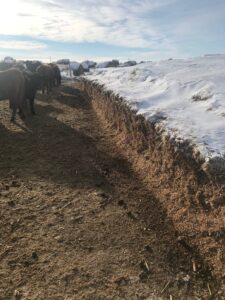
Once the silage is fully preserved and ready for use they open the face of the plastic and run a cable along the front of the pile to create a mobile silage bunk that cattle have to reach their heads over in order to eat the feed. Every few days they move the plastic and cable back to allow the cows to graze further into the silage pile.
The family also supplements the cows with slough hay that they place around the field and allow cattle to bale graze. This provides cattle with an additional fibre source and also helps to distribute manure across the field, helping to increase soil organic matter.
Although they do have problems with wildlife in some of their extended grazing fields, specifically deer, elk, and migratory birds, they don’t see as much damage where silage grazing occurs. Atchison figures that because the cows spend a significant amount of time at the face of the silage pile plus the presence of an electric wire, this is enough to deter other animals.
In other areas where they are bale grazing or swath grazing, wildlife can become a problem. One strategy they use is to ensure that there is a good ground on their electric fence which is often a challenge in sandy soils. A two-wire perimeter fence allows for each wire to be separately connected to one of two wires on interior fences used to divide swath grazing paddocks. They use pigtail posts for the interior wires and slide a plastic insulator up the post so they can run both wires without contact. In past years they have found they still had problems with deer and elk, especially when the snow was deep. They found that sacrificing some alfalfa bales and placing them around the perimeter of the field worked well to deter animals from going into the swath grazing.
Being directly in a migratory bird flightpath also presents the Atchisons with a unique set of challenges. Melissa has found that growing Golden German Millet for swath grazing which produces seed later than other cereal crops such as barley or oats, has resulted in less crop damage by birds.
Double Cropping on Irrigation and Low-Stress Handling
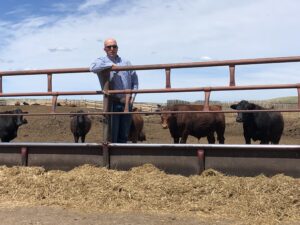
Craig Lehr – Alberta
Craig, along with his family, owns and operates Short Grass Ranches, a third generation operation consisting of a 7,000 head backgrounding feedlot, 1,200 head cow-calf ranch as well as both irrigated and dryland farmland for feed and cash crop production. Short Grass Ranches is located near Medicine Hat in southern Alberta, so drought and feed shortages have been a reality in recent years.
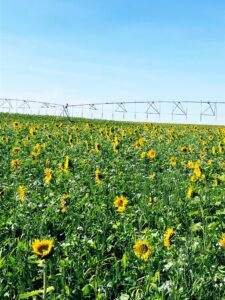
One of the ways Lehr is working to combat challenges due to drought is by using cover crops on irrigated land. This allows them to grow a second feed crop on their silage land as well as helps with soil health and fertility. Tillage radishes are added to the mixture to reduce soil compaction often caused by silage and manure trucks.
Lehr has always liked the idea of double cropping on their irrigated land and has tried it in the past but struggled to get the second crop off and dried down before winter set in. Switching to grazing has allowed them to produce a second crop without having to harvest it mechanically.
Cereal silage is grown first to be used as winter feed in the feedlot. As soon as that silage has been harvested, feedlot manure is spread on the land base and a forage mixture of winter wheat or triticale and forage radishes along with some brassicas is seeded and then irrigated. When cows come home in the fall, they are turned out on the cover crop mixture to graze. Lehr doesn’t use any cross fencing and allows the cattle to graze the entire field. He thinks that between the number of cattle on the field, the native dryland corners, and the stage of the crop, cattle seem to self-select. He has yet to have any problems with bloat or cattle selectively grazing only the highest quality or preferred plants or plant parts.
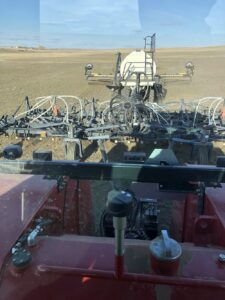
Unlike traditional crops, Lehr says they don’t seed the winter wheat for survivability. What they are looking for is a crop that cattle can graze in the fall so they seed the crop earlier than is recommended, at the end of July or beginning of August, to ensure that there is adequate growth by the time they want to turn cows out onto it. If the crop does survive over the winter, they consider that a bonus. In the spring if it looks like the winter wheat has survived, they will fertilize and then harvest the crop for silage later in the summer.
By maintaining a constant cover on their soils, Lehr has noticed an increase in the soil nutrient profile and amount of organic matter. He also notes that tillage radishes have made a big difference to their soil. The root systems go deep into the soil which has helped to reduce soil compaction.
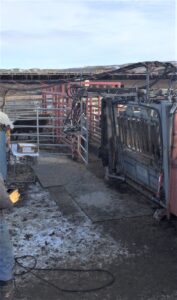
On the feedlot side, Lehr noted that installing a low-stress handling system has had a major impact on their operation. “It turned sorting cattle from something no one wanted to do to a job that no one minded doing” says Lehr. With their old system cattle movement was slow, prod use and yelling were higher than the family would like and every time the cattle had to be brought through the system they were more reluctant. The ability to sort cattle only three ways caused increased re-sorting and frustrations. By adding a new Bud box with a Daniels Alley and five-way sort system out the front that was all tied to a remote-controlled hydraulic system, Lehr was able to greatly reduce both the time and labour required for processing and resorting.
The new chute system is much more open than the previous one and allows workers to see cattle and how they are moving. It also enables the cattle to see where they are going and move more smoothly through the system. When processing cattle, Lehr thinks they have reduced both prod use and yelling by 95% where both are now a rare case. They have noticed a big difference on how cattle respond to the new system as they are much calmer before, during, and after processing.
Backgrounding and marketing even groups of feeder calves requires additional sorting through the feeding period which involves cattle being moved back through the system to get a good visual of the animal. The system is set up so that one person can run both the hydraulic system and sort gates and can sort into up to five different pens. The open design of the system provides the opportunity to fully assess each animal and allows for sorting more ways which has reduced the number of times sorting needs to be done. The new set-up not only reduces stress for the cattle but also for the workers using it.
Stay tuned for the next instalment in this series.
Click here to subscribe to the BCRC Blog and receive email notifications when new content is posted.
The sharing or reprinting of BCRC Blog articles is welcome and encouraged. Please provide acknowledgement to the Beef Cattle Research Council, list the website address, www.BeefResearch.ca, and let us know you chose to share the article by emailing us at info@beefresearch.ca.
We welcome your questions, comments and suggestions. Contact us directly or generate public discussion by posting your thoughts below.